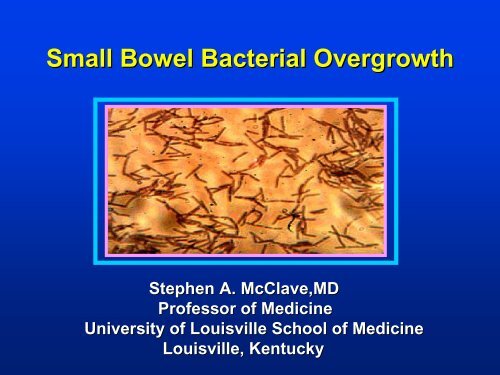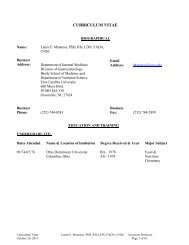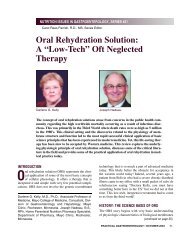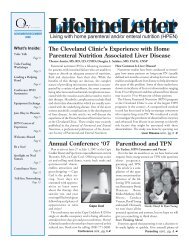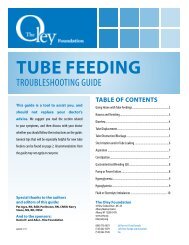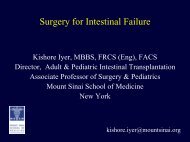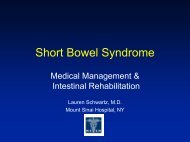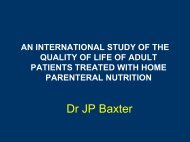Small Bowel Bacterial Overgrowth
Small Bowel Bacterial Overgrowth
Small Bowel Bacterial Overgrowth
You also want an ePaper? Increase the reach of your titles
YUMPU automatically turns print PDFs into web optimized ePapers that Google loves.
<strong>Small</strong> <strong>Bowel</strong> <strong>Bacterial</strong> <strong>Overgrowth</strong><br />
Stephen A. McClave,MD<br />
Professor of Medicine<br />
University of Louisville School of Medicine<br />
Louisville, Kentucky
Introduction<br />
• Definition<br />
Abnormal bacterial proliferation in upper SB<br />
>10,000 colony forming units (cfu/ml)<br />
Syndrome of weight loss, diarrhea and malnutrition<br />
Malabsorption of macro and micronutrients<br />
• History<br />
1897 - Association between bowel strictures and Vit<br />
B 12 deficiency (pernicious anemia)<br />
1939 - Association due to bowel stasis and bacterial<br />
overgrowth (“putrefaction”)
Normal Intestinal<br />
Ecology<br />
• <strong>Bowel</strong> colonization<br />
Sterile (birth) → Full flora at 1 month<br />
Factors – Gestational age,<br />
delivery, feeds<br />
• Levels of colonization<br />
Stomach to jejunum – sterile up to<br />
1,000-10,000<br />
10,000 cfu/ml<br />
Ileum – higher concentration<br />
100,000-1,000,000,000 1,000,000,000 (10 9 ) cfu/ml<br />
Ileocecal valve – steep gradient, some stasis<br />
Colon – Mainly anaerobes<br />
10 9 -10<br />
12 cfu/ml
Variance in <strong>Bacterial</strong> Species<br />
“Good Guys”<br />
“Bad Guys”<br />
Faculative Anaerobes<br />
Gram Positives<br />
True Anaerobes<br />
Gram Negative<br />
Coliforms
Normal Intestinal Ecology<br />
Beneficial Effects of Enteric Bacteria<br />
• <strong>Bacterial</strong> enzymes (disaccharidases) break down carb<br />
sugars to short chain fatty acids to be absorbed in colon<br />
• Some meds require bacterial metabolism for their action<br />
• Enteric bacteria produce folate, vit K<br />
• Enteric nonpathogenic bacteria (“good(<br />
guys”)<br />
prevent colonization by pathogenic orgs (“bad(<br />
guys”)
Host Defense Mechanisms<br />
• Gastric acid<br />
• Intestinal motility<br />
• Intestinal secretions with immunologic properties (IgA)<br />
• Bacteriostatic pancreatic and biliary secretions
Conditions Favoring<br />
SBBO<br />
• Anatomic<br />
SB diverticulosis<br />
Intestinal strictures (Crohn’s, XRT, Ca)<br />
Surgical blind loops (BII, JI bypass)<br />
• Motility disorders<br />
Scleroderma<br />
Diabetic autonomic neuropathy<br />
Idiopathic intestinal pseudoobstruction<br />
• Achlorhydria<br />
Surgical<br />
Atrophic gastritis, chronic H. Pylori
Conditions Favoring SBBO<br />
• Abnormal connections between proximal and distal bowel<br />
Resection IC valve<br />
Fistulas (Crohn’s, PUD, Ca)<br />
• Immunodeficiency states<br />
Common variable immunodefic<br />
Acquired immunodeficiency<br />
Malnutrition<br />
• Other conditions<br />
Cirrhosis<br />
End-stage renal disease<br />
Chronic pancreatitis<br />
Fistula
Pathogenesis of SBBO<br />
• Fat malabsorption<br />
Bacteria unravel (deconjugate) ) bile acids<br />
A toxic lithocholic acid is produced<br />
Action of bile salts
Gut<br />
Lumen<br />
Brush<br />
Border<br />
Pathogenesis<br />
of SBBO<br />
Carbohydrate metabolism<br />
Bacteria digest carbs<br />
Fermentation (hydrogen, CO 2 )<br />
Maldigestion, , osmotic load,<br />
diarrhea, pain
Pathogenesis of SBBO<br />
• Protein metabolism – lesser effect<br />
Bacteria degrade proteins, reduce AA absorption<br />
Less output of pancreatic protease enzymes
Pathogenesis of SBBO<br />
• Alterations in vitamin metabolism<br />
Bacteria utilize Vit B 12<br />
Fat-soluble<br />
Vits A,D,K,E malabsorbed<br />
Bacteria produce folate, Vit K
Clinical features<br />
• Predisposing past history<br />
Surgery<br />
Diabetes<br />
Scleroderma<br />
Crohn’s Disease<br />
Immunodeficiency<br />
Radiation Rx<br />
• Usual symptoms<br />
Asymptomatic<br />
Diarrhea<br />
Weight loss<br />
Abd pain<br />
Bloating<br />
Steatorrhea<br />
• Symptoms related to deficiencies<br />
Night blindness (Vit A)<br />
Osteomalacia (D)<br />
Anemia (B 12 ) Loss of balance (B 12 )
Diagnosis<br />
• <strong>Small</strong> bowel aspirate ( Dx >10 5 cfu/ml )<br />
Special tube to avoid contamination<br />
Best test for now<br />
• Bile acid breath test ( radiolabeled carbon C 14* )<br />
<strong>Bacterial</strong> deconjugation liberates glycine*<br />
Poor test (↓(<br />
specificity, sensitivity)<br />
• D-Xylose<br />
breath test ( radiolabeled carbon C 14 * )<br />
SB absorption occurs before sugar reaches colon<br />
Metabolism produces 14 CO 2 *<br />
Good test (85% pos 1 hr, 100% pos 3 hr)<br />
• Hydrogen breath test<br />
Bacteria ferment carb (lactulose) ) to produce H 2<br />
Early peak (represents SB) vs late peak (represents colon)<br />
Poor test (sensitivity 55%, false pos and neg)
Treatment<br />
• Correct fluid, electrolyte, nutrient deficiencies<br />
• Correct underlying anatomic abnormalities<br />
Surgery<br />
Promotility agents – Reglan, Octreotide,<br />
Erythromycin<br />
• Empiric antibiotic therapy<br />
Rationale – Rx aerobes, O2 kills anaerobes<br />
Examples – TCN, ampicillin, Flagyl, Septra<br />
Monotherapy 7-107<br />
days – Some sustained remission<br />
Rotating combination more effective<br />
• Probiotic therapy – unproven as yet<br />
Examples – Yogurt, lactobacillus GG, Saccharomyces Boulaardi<br />
Promote growth of nonpathogenic “good guys”
Syndrome of<br />
D-Lactic Acidosis<br />
• Definition – Syndrome of<br />
neurologic dysfunction<br />
• Predisposing factors<br />
Short bowel<br />
Intact colon<br />
• Physiology<br />
Fermentation of carbohydrates<br />
Production of D-LactateD<br />
• Diagnosis<br />
Metabolic acidosis<br />
Lab assay for D-Lactate D<br />
(Mayo Clinic)<br />
• Treatment<br />
Limit carbohydrates (simple >> complex)<br />
Antibiotics<br />
TPN, bicarbonate
Conclusions<br />
• Clinical consideration in complex patient<br />
• Identifying likely candidates<br />
• Empiric diagnosis and treatment


